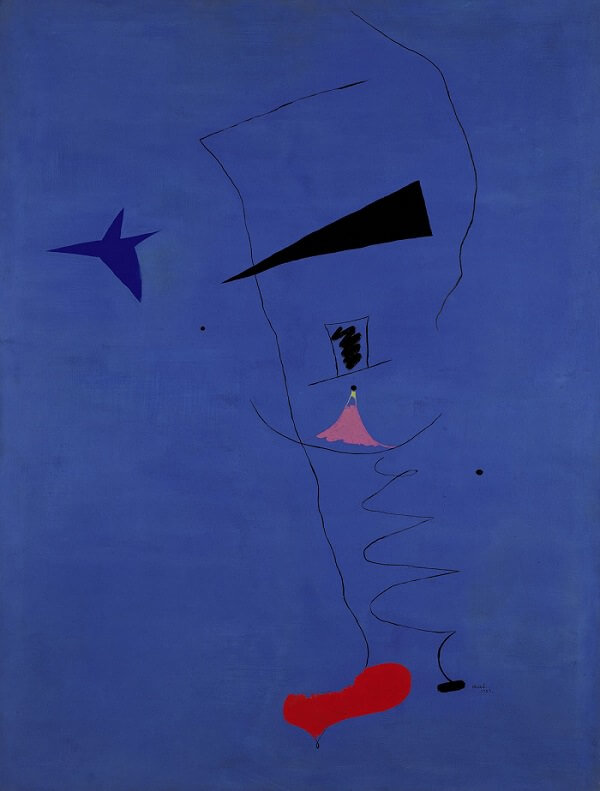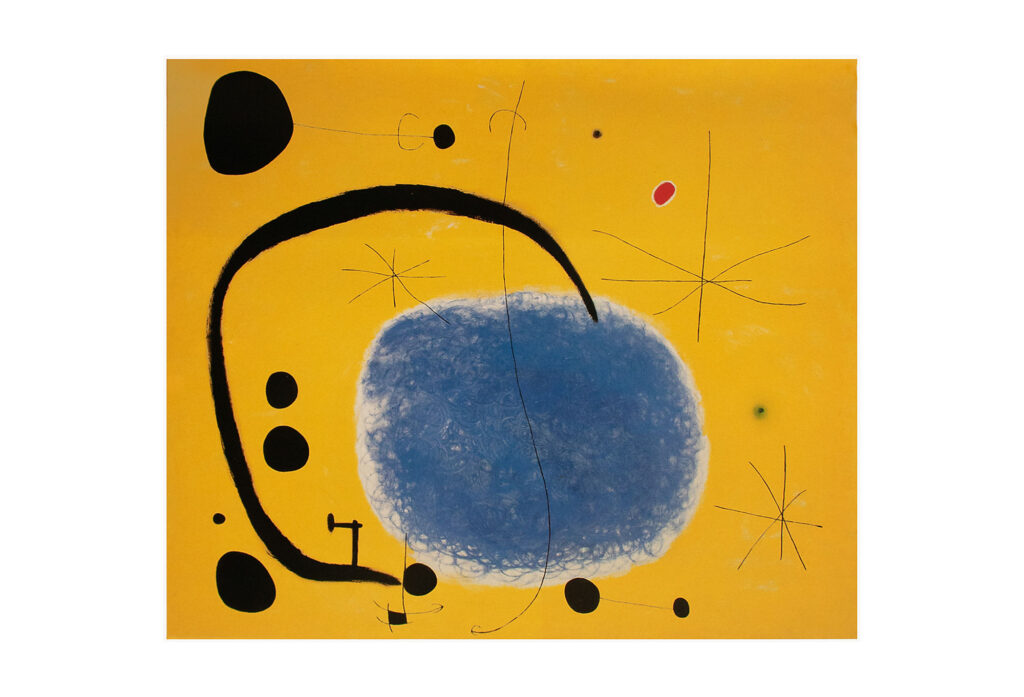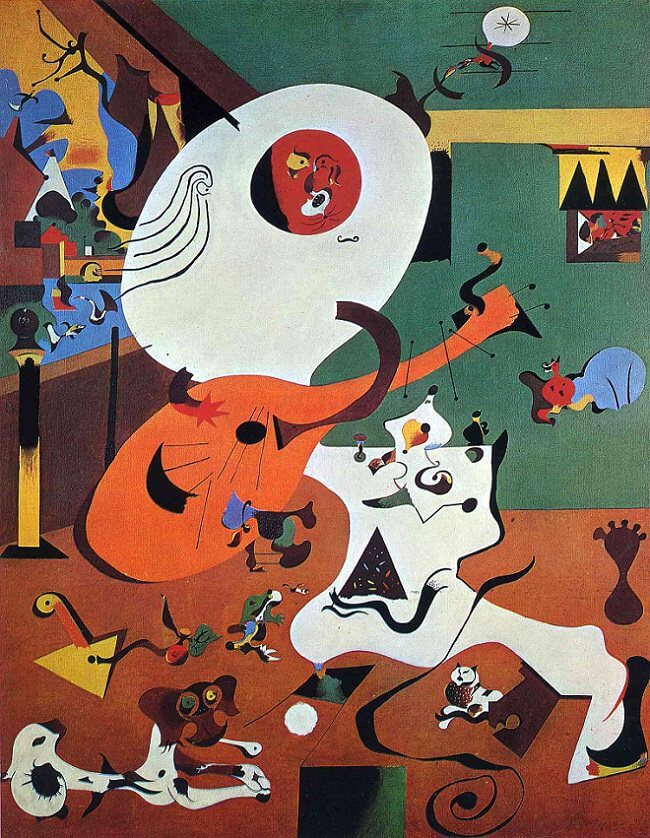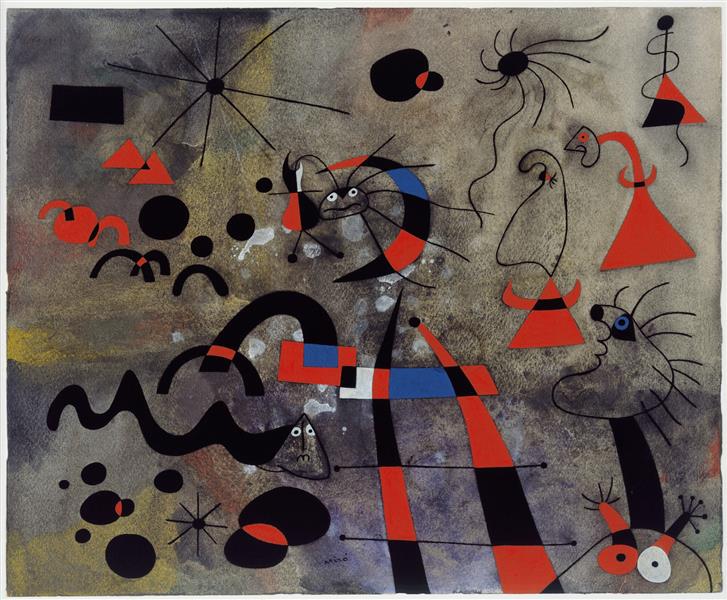Joan Miró paintings graced the art world with a whimsical palette and an imagination that danced freely across canvases. Born on April 20, 1893, in Barcelona, Spain, Miró’s artistic journey commenced with formal education at the Royal Academy of Fine Arts of San Jorge, where he studied from 1907 to 1910. His familial roots deeply entwined with a goldsmithing lineage, Miró was set on a path where creativity and craftsmanship seamlessly converged. Early familial influences laid the foundation for his unique artistic vision, steering him towards a career that would redefine the boundaries of artistic expression.
Miró’s career took flight in the early 20th century, influenced by the tumultuous socio-political landscape of his time. His early works bore the marks of Fauvism and Cubism, but it was the gravitational pull towards the surreal that truly distinguished him. A journey to Paris in 1920 became a pivotal moment, where Miró was exposed to the burgeoning surrealist movement and the works of contemporaries like Picasso and André Masson. From this point forward, Miró embarked on a personal and artistic odyssey, birthing a style that would become synonymous with whimsy, symbolism, and a profound connection to his Catalan roots.
1. The Farm

| Date of Completion | 1921-1922 |
| Dimensions | 123.2 cm × 122.3 cm |
| Location | National Gallery of Art, Washington, D.C. |
“The Farm” stands as a testament to Miró’s skill to transform the ordinary into the extraordinary. Painted between 1921 and 1922, this masterpiece serves as a kaleidoscopic memoir of Miró’s childhood home in Mont-roig, Catalonia. Miró invites us into his world, where pigs and hens dance amidst a riot of colors, turning the mundane into a whimsical dreamscape.
2. Harlequin’s Carnival

| Date of Completion | 1924-1925 |
| Dimensions | 66 cm × 92 cm |
| Location | Albright-Knox Art Gallery, Buffalo, New York |
Step right up to “Harlequin’s Carnival,” Miró’s visual extravaganza that catapults us into the heart of a circus celebration. Completed between 1924 and 1925, this painting is a riot of colors and shapes, where clowns and acrobats cavort in a kaleidoscope of movement. Miró’s brush is a magician’s wand, turning the canvas into a dynamic carnival that captures the spirit of joy and spontaneity.
3. The Tilled Field

| Date of Completion | 1923-1924 |
| Dimensions | 66 cm × 92 cm |
| Location | National Gallery of Art, Washington, D.C. |
“The Tilled Field” is Miró’s experimental playground, painted between 1923 and 1924. Here, he dabbles with form and color, laying the groundwork for his unique surrealist language. The canvas becomes a whimsical mosaic of symbols and shapes, a precursor to the fantastical worlds Miró would later invite us to explore.
4. The Hunter (Catalan Landscape)

| Date of Completion | 1923-1924 |
| Dimensions | 124 cm × 85 cm |
| Location | Joan Miró Foundation, Barcelona, Spain |
As we delve into “The Hunter,” completed between 1923 and 1924, Miró guides us through the rustic beauty of the Catalan landscape. Bold strokes and earthy tones create a visual narrative, and the enigmatic hunter adds an air of mystery to this captivating composition. It’s as if Miró is inviting us on a quest into the heart of his homeland.
5. Woman and Birds in the Night

| Date of Completion | 1945 |
| Dimensions | 115 cm × 88 cm |
| Location | Private Collection |
“Woman and Birds in the Night” unveils Miró’s fascination with the mystical and cosmic realms. Painted in 1945, this artwork is a poetic exploration of the connection between the human and the celestial. Ethereal figures and dreamlike atmosphere beckon us to join Miró on a journey through the mysteries of the night sky.
6. Painting (Blue Star)

| Date of Completion | 1927 |
| Dimensions | 115 cm × 88 cm |
| Location | Peggy Guggenheim Collection, Venice, Italy |
“Painting (Blue Star)” is Miró’s declaration of color mastery, painted in 1927. Here, a bold star takes center stage in a symphony of blues and greens. Miró’s use of symbolism and abstraction allows us to interpret the painting in our own way, making the experience deeply personal and engaging.
7. The Gold of the Azure

| Date of Completion | 1993 |
| Dimensions | 73 cm × 92 cm |
| Location | Joan Miró Foundation, Barcelona, Spain |
In “The Gold of the Azure,” completed in 1993, Miró’s late-career brilliance shines through. Rich hues of gold and blue create a harmonious composition, offering a soothing and mesmerizing experience. Miró, like a seasoned magician, continues to push the boundaries of artistic expression, leaving us in awe of his evolving mastery.
8. Dutch Interior I

| Date of Completion | 1928 |
| Dimensions | 130.5 cm × 88.9 cm |
| Location | The Metropolitan Museum of Art, New York City |
“Dutch Interior I” invites us into Miró’s whimsical dollhouse, painted in 1928. A blend of geometric shapes and whimsical forms transforms the ordinary into the extraordinary. It’s like Miró played interior decorator in Wonderland, and this masterpiece is the result – a riot of color and imagination.
9. The Smile of the Flamboyant Wings

| Date of Completion | 1953 |
| Dimensions | 130 cm × 89 cm |
| Location | Joan Miró Foundation, Barcelona, Spain |
A grin frozen in time, “The Smile of the Flamboyant Wings” is a radiant burst of positivity. Completed in 1953, Miró’s playful spirit is on full display with vibrant colors and a dynamic composition. It’s like Miró painted joy and hung it on the wall, inviting us to bask in the contagious celebration of life.
10. The Escape Ladder

| Date of Completion | 1940 |
| Dimensions | 114.9 cm × 146 cm |
| Location | MoMA – The Museum of Modern Art, New York City |
“The Escape Ladder” is Miró’s call to climb into the unknown. Painted in 1940, the ladder became a symbol of liberation and exploration. Miró invites us to embark on our own journey of self-discovery, a theme that resonates throughout his body of work.
Frequently Asked Questions
Why was Joan Miro so famous?
Miró was a multimedia artist, as seen by his exquisite ability to paint, print, sculpt, and create murals. He produced an incredible amount of work, which included 400 ceramic items, 500 sculptures, and 2,000 oil paintings. Miró was among the most prolific producers of original lithographs and etchings.
How much is Joan Miro art?
Depending on the scale and medium of the artwork, Joan Miró’s work has been sold at auction on several occasions, with realized prices ranging from 2 USD to 37,064,980 USD. The artist’s highest auction price since 1998 is 37,064,980 USD for PEINTURE (ÉTOILE BLEUE), which was sold at Sotheby’s London in 2012.
Conclusion
In conclusion, Joan Miró’s art is not just a visual feast; it’s an invitation to dance in the kaleidoscope of his imagination. With each stroke, he beckons us to join the celebration of color, form, and whimsy. So, the next time you stand before a Miró masterpiece, don’t just look – let your imagination run wild, and dance to the vibrant rhythm of his brush!













